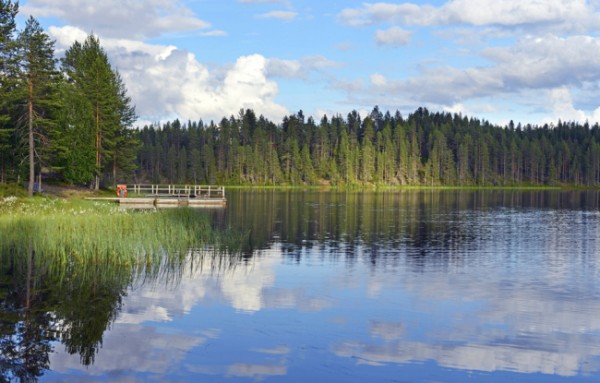Managing Our Dynamic Freshwater Resources
By West M. Bishop, Algae and Aquatic Research Scientist, and Ben E. Willis, Aquatic Research Technician, SePRO Corporation

Have you noticed freshwater resources to be less pristine than they once were? Perhaps you have seen increased frequencies, densities, and durations of nuisance algae blooms; or even decreased responses of algae to typical management efforts.
As our water resources age, there is often a continued accumulation of nutrients that drives numerous negative implications in water resources. This process, called eutrophication, can increase turbidity, anoxia, and overall algae biomass. Coupled with climate change, an increase in nuisance and noxious blue-green algae (cyanobacteria) infestations has arisen (Carpenter et al. 1992). Cyanobacteria are of particular concern due to their ubiquitous presence and unique competitive characteristics. With their documented ability to tolerate dynamic environmental conditions, cyanobacteria have unique capabilities to withstand human-induced changes occurring today (Schopf 2000).
Some of the ways our waters may actually be promoting nuisance cyanobacteria are:
Stagnant waters near the surface (often from drought conditions) can warm more intensely (stratification), which can allow cyanobacteria to thrive and out-compete other algae. Cyanobacteria also have the ability to adjust their buoyancy via gas vacuoles which is more pronounced in still waters. This vertical movement allows scum formation which in turn can block sunlight and radiate heat to cook other algae (Paerl and Huisman 2008). Large rains may temporarily improve a water body’s appearance; though often only bring additional nutrients to fuel worse blooms after subsiding.
Stratified water can create anoxic zones near the sediments (where historic phosphorus may accumulate) promoting release of sediment-bound phosphorus from forms previously unavailable to algae. Cyanobacteria, with their buoyancy regulation can migrate to these depths and acquire released phosphorus (Perakis et al. 1996). Furthermore, phosphorus is indicated as the key limiting nutrient for cyanobacteria especially as many can fix atmospheric nitrogen (Paerl 1990; Schindler et al. 2008).
Upon acquisition of phosphorus from external sources (fertilizer, animal waste, etc.) or internal sources (sediments), cyanobacteria can increase in biomass and be less responsive to algaecide treatments (i.e. more algae = more algaecide and healthier algae = tougher algae) (Bishop and Rodgers, 2012; Twiss and Nalewajko 1992).
With these changes in our freshwater systems and documented cyanobacteria adaptations, what can be done to mitigate unwanted impacts for more efficient management?
Maintaining moving waters (fountains and aerators) to reduce cyanobacteria scum and prevent buoyancy regulation as a competitive advantage is a potential management option, although some cyanobacteria prefer moving waters. However, dependence on phosphorus is a critical component of their physiology that we can address. As waters we manage evolve, and our understanding of system dynamics and organism ecology increases, the use of new, innovative and integrated solutions is needed to succeed.
Literature Cited
- Bishop WM, Rodgers JH Jr. 2012. Responses of Lyngbya wollei to exposures of copper-based algaecides: The critical burden concept. Archives of Environmental Contamination and Toxicology 62: 403-410.Carpenter SR, Fisher SG, Grimm NB, Kitchell JF. 1992. Global change and freshwater ecosystems. Annual Review of Ecology and Systematics 23: 119-139.
- Paerl HW, Huisman J. 2008. Blooms like it hot. Science 320: 57-58.
- Paerl HW. 1990. Physiological ecology and regulation of N2 fixation in natural waters. Advances in Microbial Ecology 11: 305-344.
- Perakis SS, Welch EB, Jacoby JM. 1996. Sediment-to-water blue-green algal recruitment in response to alum and environmental factors. Hydrobiologia 318(3): 165-177.
- Schindler DW, et al. 2008. Eutrophication of lakes cannot be controlled by reducing nitrogen input: Results of a 37-year whole-ecosystem experiment. Proceedings of the National Academy of Sciences (USA) 105: 11254-11258.
- Schopf JW. 2000. The fossil record: Tracing the roots of the cyanobacterial lineage, in B. A. Whitton and M. Potts, eds., The ecology of cyanobacteria: Dordrecht, The Netherlands, Kluwer Academic Publishers, p. 13-35.
- Twiss MR, Nalewajko C. 1992. Influence of phosphorus nutrition on copper toxicity to three strains of Scenedesmus acutus (Chlorophyceae). Journal of Phycology 28: 291-298.
To enable comments sign up for a Disqus account and enter your Disqus shortname in the Articulate node settings.